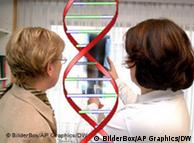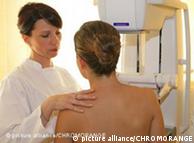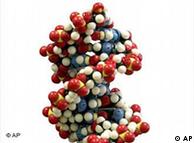GENETICS | 15.09.2011
Scientists achieve genetic breakthrough with German genome
While human gene sequencing has been increasingly conducted since the publication of the first genome map over a decade ago, Margret Höhe and her fellow researchers at the Max Planck Institute for Molecular Genetics in Berlin have managed to resolve a human genome at its molecular level – something never before achieved.
Up until now, the human genome has been treated as one unit, which, as Höhe explains, is a fundamental error.
"The first genome was read at the beginning of our decade, but that was actually a misleading product," she explained in an interview to Deutsche Welle. "Every person actually has two genomes, which contain two genetic codes – one from the mother and one from the father."
These two genomes are different, and only by obtaining information about both haplotypes, the name researchers have given to the different variants of the gene sequence on the individual chromosomes, can the overall genome be completely analyzed.
The team's findings were published in this month's issue of the journal Genome Research.
Seeing double
 The researchers' discovery could change the way other scientists look at genesCurrent sequencing technologies, however, haven't been able to read the genomes separately and only through combining a variety of technologies into a new method have Höhe and her colleagues been able to achieve this first in genetics.
The researchers' discovery could change the way other scientists look at genesCurrent sequencing technologies, however, haven't been able to read the genomes separately and only through combining a variety of technologies into a new method have Höhe and her colleagues been able to achieve this first in genetics."With this breakthrough, we can now look at all genes much closer," she said. "Through decoding both sets of chromosomes from a human genome separately, we've reached the molecular basis for individual medicine and individual therapies. We'll be able to say that this person has this exact genetic makeup and that can go a long way in dealing with diseases."
The genome that Höhe and her colleagues used for their research is that of a 51-year-old German male. The study however isn't specific to this nationality, she stressed.
"Our study covers the genetic makeup of a Caucasian European, which encompasses a variety of nationalities in addition to Germans, such as French people and even North Americans of European descent," she said.
Promising progress
The breakthrough achieved has also been lauded by others in the scientific community.
 Höhe hopes to use this work to help breast cancer patients"Genetic sequencing has been developing rapidly in the past few years, with a high number of genomes published, whether they were American, Korean or European," said Simon Myers, a bioinformatics lecturer at Oxford University, who was not part of the research.
Höhe hopes to use this work to help breast cancer patients"Genetic sequencing has been developing rapidly in the past few years, with a high number of genomes published, whether they were American, Korean or European," said Simon Myers, a bioinformatics lecturer at Oxford University, who was not part of the research."All genetic sequencing up until now has grabbed a small part of DNA, but which parent it comes from was not clear. Now we can assemble two copies of DNA in two units and better observe mutations in genes."
Author: Laura Schweiger
Editor: Cyrus Farivar
Editor: Cyrus Farivar
DW


No comments:
Post a Comment